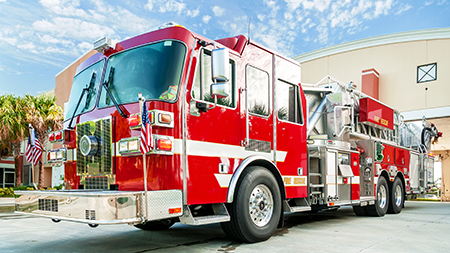EVOC: Emergency Vehicle Operator Course
Developed by FireRescue1 Academy, our Emergency Vehicle Operator Course (EVOC) is a video training series that teaches first responders the necessary skills to operate an emergency vehicle safely. As a five-part series, these courses are designed to enhance vehicle safety operations by emphasizing theory and principles of defensive driving in both emergency and non-emergency situations. In this series, first responders will learn how emergency driving differs from non-emergency driving.
This interactive EVOC training series provides a blended learning experience and meets various policies, procedures, and specified requirements found in the listed professional standards, best practices, and training programs.
- Risk Control Services Department of the Glatfelter Insurance Group, Volunteer Firemen’s Insurance Services. (2015) Risk Communique Technical Reference Bulletin: Emergency Vehicle Response Guidelines
- National Fire Protection Association. (2017) NFPA: Standard 1002, Standard for Fire Apparatus Driver/Operator Professional Qualifications
- National Fire Protection Association. (2016) NFPA: Standard 1912, Standard for Fire Apparatus Refurbishing
- National Fire Protection Association. (2017) NFPA: Standard 1911, Standard for the Inspection, Maintenance, Testing, and Retirement of In-Service Emergency Vehicles
- National Fire Protection Association. (2016) NFPA: Standard 1901, Standard for Automotive Fire Apparatus; National Fire Protection Association. (2000) NFPA: Standard 1915, Standard for Fire Apparatus Preventive Maintenance Program
- International Fire Service Training Association. (2006). Pumping Apparatus Driver Operator Handbook (2nd. ed.). Stillwater, OK: Fire Protection Publications, Oklahoma State University
- United States Fire Administration. (1996) Emergency Vehicle Driver Training. Washington DC.: United States Federal Emergency Management Agency.
| Course Name | Course Description | Length |
|---|---|---|
| Distracted Driving for First Responders – NEW! | We live in a world of constant distractions. Research indicates at least once a day upwards of 70% of Americans on the road are distracted from driving. The number of distracted drivers on the nation’s roadways makes it even more dangerous for first responders to drive distracted themselves. This 1-hour course raises awareness of distractions inside and outside of the emergency vehicle, including the risks associated with cell phone use, radio operation, and fatigued operators. First responder drivers will learn strategies for eliminating controllable distractions and making necessary adjustments for uncontrollable distractions. | 1h |
| Emergency Vehicle Driving Requirements | This 30-minute course explains the importance of emergency vehicle driving, the impact of vehicle accidents to you and the organization, responsibilities for safe emergency vehicles operations, and the factors that contribute to an incident involving emergency vehicles. Learners will take away an essential understanding of the complexities of driving under emergency conditions, the hazards of intersections and finally the risks of backing apparatus and vehicles. | 30m |
| Selecting the Proper Personnel for Driving Emergency Vehicles | This 30-minute course will explain that proper personnel selection procedures are the first steps in developing an effective, safe emergency vehicle driver program. It will also define the legal aspects of emergency vehicle operations. And why it is necessary to have standard operating guidelines. | 30m |
| Emergency Vehicle Characteristics | This 30-minute course will focus on vehicle features that the Emergency Vehicle Driver should know. The course will define the various types of Emergency Vehicle Inspections and maintenance programs a department must have set-up. The course will also focus on the different weight distribution factors and center of gravity when driving these emergency vehicles. | 30m |
| Emergency Vehicle Driving Dynamics | This course will focus on the dynamics of how to drive an emergency vehicle and stay safe in the process. It will focus on how to prevent Emergency Vehicle Roll Over and Vehicle Dynamics and Physical Forces effect the operation of these types of vehicles. | 30m |
| Emergency Vehicle Driving Techniques | This 1-hour module will cover all the techniques needed to maintain the highest level of safety possible. It also includes how to prepare for unexpected situations and conditions which can adversely affect emergency vehicle operation. As well as defensive driving techniques that include space management, following distance and rate of closure, hazard identification and correct braking techniques to name a few tactical skills. | 1h |

